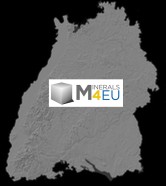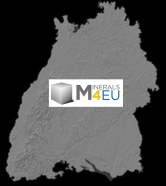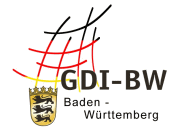Type of resources
Available actions
Topics
INSPIRE themes
Keywords
Contact for the resource
Provided by
Years
Formats
Representation types
Update frequencies
status
Service types
Scale
Resolution
-
Dieser Dienst stellt die Geodaten bereit, welche aus dem System zur Identifizierung landw. Parzellen (LPIS) stammen und somit das Referenzsystem für die flächenbezogenen Agrarzahlungen abbilden. In Baden-Württemberg wird das Katasterflurstück als Referenzparzelle genutzt. Das System zur Identifizierung landwirtschaftlicher Parzellen ist ein Teilsystem des Integrierten Verwaltungs- und Kontrollsystems (InVeKoS) im Sinne von Artikel 68 der Verordnung (EG) Nr. 1306/2013. Die Daten werden für die gesamte landwirtschaftliche Fläche Baden-Württembergs aufgrund § 3 Abs. 1 der InVeKoS-Verordnung erhoben und laufend auf Basis aktueller Luftbilder (Orthophotos) und Fernerkundungsdaten weiter gepflegt. Weitere Informationen zur Agrarpolitik und Förderung in Baden-Württemberg finden Sie unter: https://foerderung.landwirtschaft-bw.de/pb/,Lde/Startseite. Der Erfassungsmaßstab der Daten beträgt ca. 1:5.000. Die Bodenbedeckung, auch Nutzungsart, ist auf den einzelnen Referenzparzellen abgegrenzt und kann folgende Eigenschaften haben, siehe folgende Liste. Je Referenzparzelle sind mehrere Nutzungsarten möglich: Ackerland, Grünland, Dauerkultur, Landschaftselement, Nicht landwirtschaftliche Fläche. Neben der Bodenbedeckung/Nutzungsart hat jede Geometrie einen eindeutigen Identen, die FLIK der Referenzparzelle, die für Direktzahlungen förderfähige Höchstfläche in ha und eine Angabe zur Aktualität des Datenstandes. Der Erfassungsmaßstab der Daten beträgt ca. 1:5.000.
-

Since 1999, the Geologic Survey of Baden-Württemberg publishes a statewide geological map series 1 : 50 000 "Karte der mineralischen Rohstoffe 1 : 50 000 (KMR 50)". On it, the distribution of near-surface mineral raw material prospects and occurrences (mainly) and deposits (subordinate) is shown. This continuously completed and updated map currently covers around 60% of the federal state. It is the base for the regional associations in the task of mineral planning. The prospects and occurrences are classified according to different raw material groups (e.g. raw material for crushed stone (limestone, igneous rocks, metamorphic rocks, sand and gravel), raw materials for cement, dimension stone, high purity limestone, gypsum ...). Their spatial delineation is based on various group-specific criteria such as minimum workable thickness, minimum resources, ratio overburden/workable thickness, and so on. It is assumed that they contain deposits as a whole or in parts. In the vast majority of cases, the data is not sufficient for the immediate planning of mining projects, but it does facilitate the selection of exploration areas. The name of each area (e.g. L 6926-3) consists of three parts. L = roman rnumeral fo 50, 6926 = sheet number of the topographic map 1 : 50 000, 3 = number of the area/mineral occurrence shown on this sheet. Co-occurring land-use conflicts, e.g. water protection areas and nature conservation areas, forestry and agriculture, are not taken into account in the processing of KMR 50. Their assessment is the task of land use planning, the licensing authorities and the companies interested in mining. The data is stored in the statewide raw material area database "olan-db" of the LGRB.
-

2m temperature measurements at DWD stations in the Regional Basic Synoptic Network of the WMO, plus additional stations from the so called "Global Dataset" of DWD
-
wind speed measurements at DWD stations in the Regional Basic Synoptic Network of the WMO, plus additional stations from the so called "Global Dataset" of DWD
-
precipitation measurements at DWD stations in the Regional Basic Synoptic Network of the WMO, plus additional stations from the so called "Global Dataset" of DWD
-

Since the end of the 1980ies the geological, areal and production data of operating mining sites have been collected systematically by LGRB. The periodic update of this information is carried out every four or five years. Main reasons are 1) the preparation of the periodic follow-up of the 12 regional development plans, 2) the work on the near-surface mineral raw material maps published by LGRB, and 3) the periodical editing of the state report for near-surface mineral raw materials published by LGRB at the start of each new election period. The geological data include a detailed documentation of the thickness, petrography and quality of mined rock(s) and the overburden as well as geochemical data gained from rock samples. The areal data refer both to the permitted mining area (zones of recultivation, work and expansion) and to possible areas for the mine expansion (the latter are confidential). Due to the quick spatiotemporal variability of these data, here all mining sites are shown as point data. The confidential annual production data are the basis for the periodic raw material report. In addition, another data are collected, e.g. for the mining permission, the delivery area and the subsequent land use. All these data are stored in the mining site database of the LGRB (Rohstoffgewinnungs-stellendatenbank = RGDB). This one comprises also the data for abandoned mining sites and mines. In total, actual (2021) about 14.000 data records are stored. The name of each mining site (e.g. RG 6826-3) consists of three parts. RG is the abbreviation for "Rohstoffgewinnungsstelle". the following four-digit number means the number of the relevant topographic map 1 : 25.000. The last number means the serial number of the mining site; serial numbers 1-99 mark operating mining sites gathered since the end of the 1980ies ( (today partially already closed) , such > 100 mark abandoned mining sites collected before 1980 and such > 300 mark data of mining sites and mines collected in the course of actual raw material mapping. The mintell4eu data set comprises all mining sites with serial numbers 1-99. In addition, the most important abandoned mines of former or probably still ongoing economic importance.
-

BW Map mobile ist eine App für iOS (iPhone / iPad) und Android (Smartphone / Tablet). Enthalten sind Amtliche Topographische Karten von Baden – Württemberg 1:10.000, 1:50.000, 1:200.000, 1:500.000 und 1:1 Million. Die App "BW Map mobile" ist im AppStore kostenlos erhältlich. Diese kann mit dem Kartendienst "Maps4BW" genutzt werden. Über einen In-App-Kauf (IAK) der "Jahres-Flatrate" aus der kostenlosen App heraus, werden erweiterten Funktionen aktiviert, inklusive den Zugriff auf die Topographischen Karten. Die Darstellungen 1:1 Million und 1:500.000 sind aus dem DLM1000 und die Topographische Übersichtskarte 1:200.000 aus dem DLM250. Die Darstellung 1:50.000 basiert auf dem DLM50. Die kartographische Darstellung 1:10.000 basiert auf dem Basis-DLM und der Gebäudedaten des Amtlichen Liegenschaftskatasterinformationssystems (ALKIS). Die Höheninformationen innerhalb Baden-Württembergs bestehen aus dem Digitalen Geländemodell (DGM25). Das DGM basiert auf dem Höhenbezugssystem „Höhen im Neuen System“ des Deutschen Haupthöhennetzes 1912 (DHHN 12 – HST 130) mit dem Pegel von Amsterdam. Zur Höhendarstellung außerhalb Baden-Württembergs wurden SRTM-3 Höhendaten des United States Geological Survay genutzt. Bezugssystem ist das Europäische Terrestrische Referenzsystem 1989 (ETRS89) und die Kartenprojektion die Universale Transversale Mercatorabbildung (UTM), Zone 32. Weitere Funktionen der App: GPS-Position, Moving Map (IAK), Trackaufzeichnung, Sprachführung entlang von Tracks, Suche (Orte, Straßen, Berge, Gewässer ...), Haltestelleninformationen, Meldefunktion, Messen von Strecken und Flächen. Sprachen DE,EN,FR,IT Erweiterte Funktionen für iOS sind: Panorama-Ansicht (3D-Karte), Augmented Reality. Weitere Angaben unter: http://www.lgl-bw.de/lgl-internet/opencms/de/07_Produkte_und_Dienstleistungen/Karten/BW-Map-mobile/Grundlegendes/
-
Die landesweite Erstfassung der Daten für die Berechnung des Digitalen Geländemodells (DGM) / Digitalen Oberflächenmodells (DOM) erfolgte in den Jahren 2000 bis 2005 über Laserscanbefliegung. Die Fortführung der Daten des DGM erfolgt seither partiell auf Datengrundlagen unterschiedlicher Erfassungmethoden. Dieser Dienst setzt sich aus fünf Ebenen zusammen. Die Ebene "ATKIS DGM Laserflüge ALS 1 (2000-2005)" zeigt die Laserfluggebiete der Erstfassung. Get FeatureInfo gibt Auskunft über Flugdatum, Punktdichte, Scanner, Scanwinkel und Flughöhe. Die Ebene "ATKIS DGM Fortführung aus Laserscanning-Daten (2009-2015)" zeigt die Fortführungsgebiete, die über Laserflüge erfasst wurden, die Ebene "ATKIS DGM Fortführung über sonstige Methoden (2011-2015)" Fortführungsgebiete, die mittels Terrestrisches Laserscanning, Bildflügen oder UAV durchgeführt wurden. Get FeatureInfo gibt jeweils Auskunft über Name des Erfassungsgebietes, -,datum, -methode, Losnummer sowie Fortführungsdatum des DGMs. Die Ebene "ATKIS DGM Bearbeitungsübersicht ALS 2 (2016-2021)" zeigt die Darstellung der verfügbaren DGM km² Kacheln aus der Laserscanbefliegung (Punktdichte 8 Punkte\m²) von 2016-2021 mit Flugdatum und die Ebene "ATKIS DGM Laserflüge ALS 2 (2016-2021)" zeigt die Darstellung der Losabgrenzungen der Laserbefliegung für die flächenhafte Aktualisierung von DGM und DOM aus durchgeführten Laserscanbefliegungen (Punktdichte 8 Punkte\m²) von 2016 bis 2021. Get FeatureInfo gibt jeweils Auskunft über Los, Flugdatum, Punktdichte, Scanner, Scanwinkel und Flughöhe. Es wird darauf hingewiesen, dass keine Rechtsverbindlichkeit für die gelieferten Daten besteht.
-
relative humidity measurements at DWD stations in the Regional Basic Synoptic Network of the WMO, plus additional stations from the so called "Global Dataset" of DWD
-
calculated values for potential Evaporation over gras at DWD stations in the Regional Basic Synoptic Network of the WMO, plus additional stations from the so called "Global Dataset" of DWD
 Metainformationssystem GDI-BW
Metainformationssystem GDI-BW